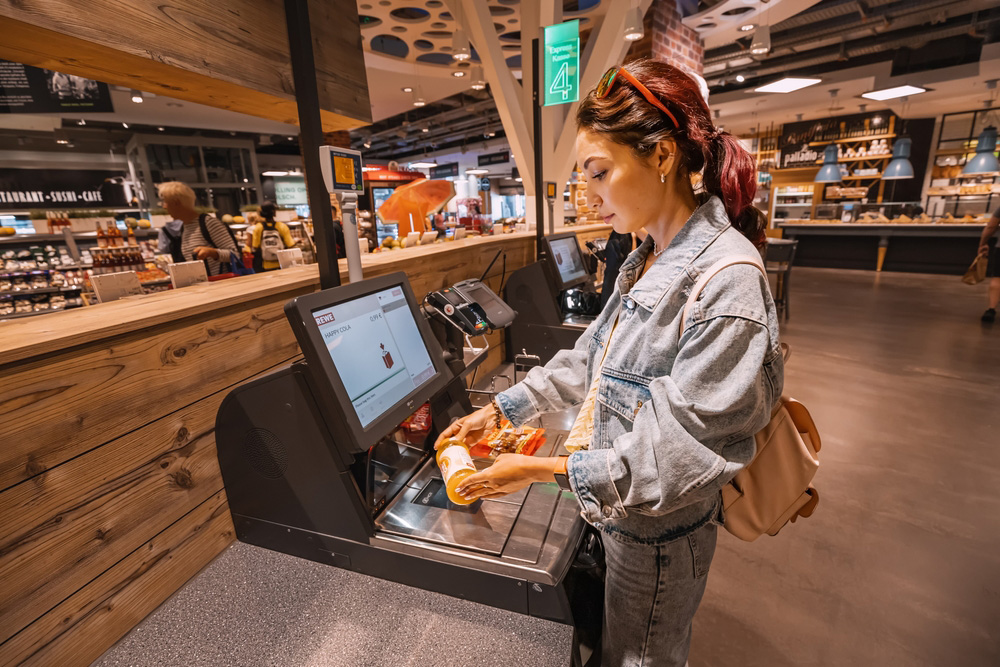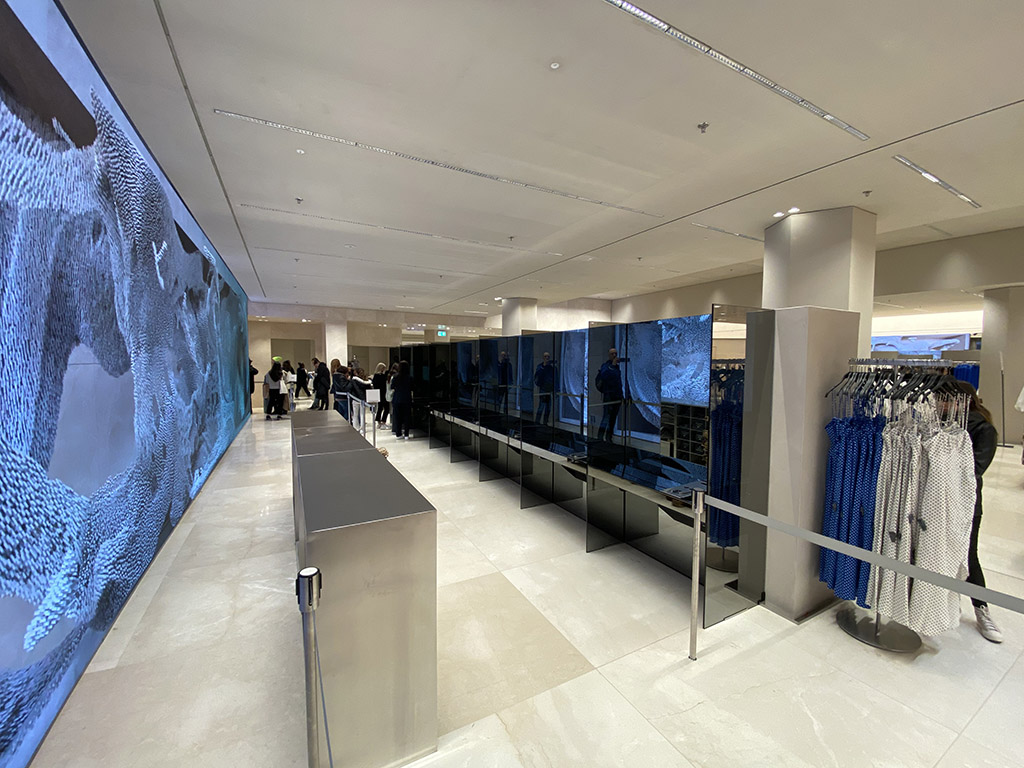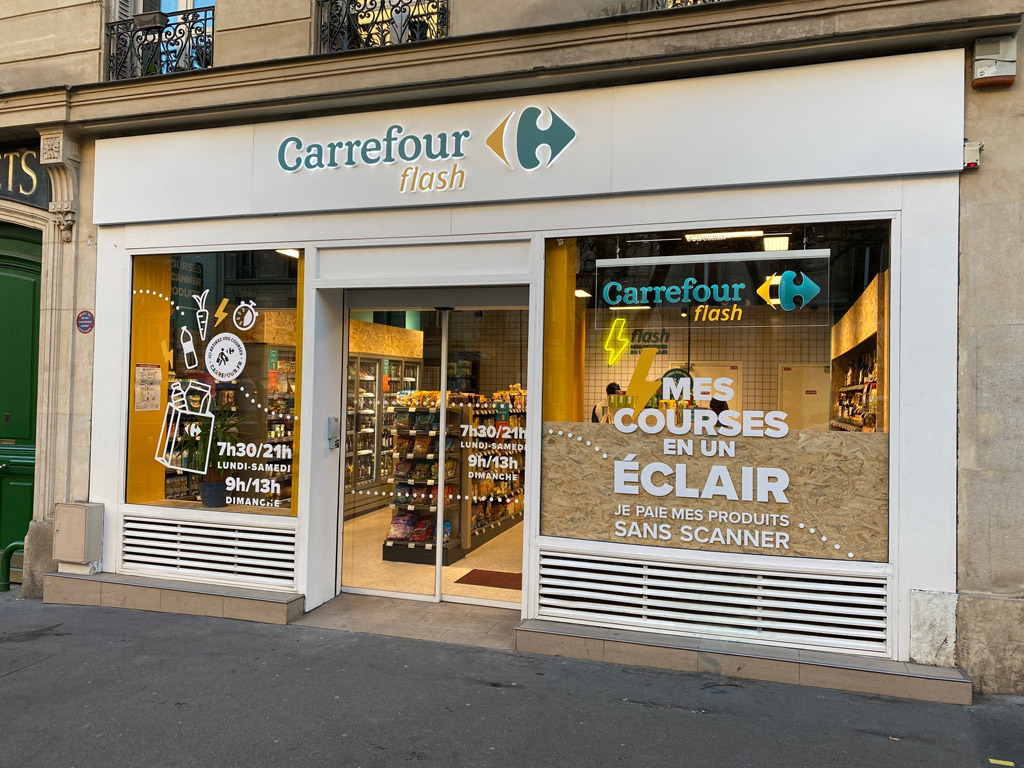In this article, I explain why retailers remove automatic checkouts from their outlets. I also look at the technologies that could replace them, so the in-store customer experience doesn’t suffer.

What does the future hold for automatic checkouts? After the early years of enthusiasm, automatic checkouts are now causing concern among retailers who question the cost-benefit ratio. The explosion in theft is calling into question the staff savings achieved. This leads us to wonder about the future of in-store payment.
Contact IntoTheMinds market research agency
9 statistics on automatic checkouts
- The 1st automatic checkout was installed in France in June 2004.
- The 10,000th automatic checkout was installed in France in 2014
- In Belgium, 50% of Carrefour and Delhaize customers choose automatic checkouts
- Personnel costs represent 10-12% of a supermarket’s operating costs.
- The number of cashiers in France fell by 19% between 2009 and 2020
- One employee can supervise up to 5 automatic checkouts
- By 2024, 71% of supermarkets and hypermarkets will have automatic checkouts
- In the United States, Dollar General has eliminated automatic checkouts from 300 of its outlets
- Theft leads to a 5% loss in sales with automatic checkouts, compared with 1% with traditional checkouts.

Zara’s flagship store on the Champs-Elysées (Paris) features automatic checkouts equipped with a scale.
Automatic checkouts arrived in Europe in the early 2000s and spread like wildfire. Their advantages had everything to appeal to retailers: flexibility, availability, and lower personnel costs. In France, for example, the number of cashiers fell by 19% between 2009 and 2020. This widespread trend led several media outlets to claim that the cashier was on the verge of extinction. The wave of “employee-free stores” also affected Europe following the proliferation of automated stores in the USA. But the movement has run out of steam. Amazon is closing its Amazon Go stores, and Carrefour has closed its Carrefour Flash automated store. What’s going on? Why are technologies that were supposed to save retailers millions being scrapped?

“Carrefour Flash” was a stand-alone store set up by Carrefour in Paris. It allowed customers to shop autonomously and pay via automatic checkouts.
Why are automatic checkouts disappearing
The fate of automatic checkouts was sealed when inflation entered our lives. Consumers needed to make savings to maintain their standard of living, and theft became a national sport. It is estimated that the loss of sales is now close to 5% on automatic checkouts, compared with just 1% on traditional checkouts.
Retailers will tell you that the customer experience drives them back to a traditional checkout model. Please don’t believe them. In an industry with low operating margins, losses of 5% are simply unacceptable.
Remember that retailers are fighting to reduce losses and that efforts are focused on tenths of a percentage point. Losses of 5% are simply out of proportion and can even be threatening.
Fortunately, theft has not yet reached the same proportions as in the USA (see video below), where stores are vandalized in broad daylight. However, methods of securing products that were freely available yesterday are multiplying. This summer, for example, I saw a €2.99 bottle of wine with an anti-theft device in an Italian supermarket. Who could have imagined this just a few years ago?
The model of the employee-free store is outdated
Theft has had its way with automatic checkouts. It’s also one of the reasons why some retailers are no longer investing in stand-alone stores. But it’s not the only one.
Autonomous stores were a fad on the other side of the Atlantic, allowing retailers to evaluate their technological development capabilities. And I think that, from this point of view, it has been rather successful. Amazon has been a pioneer, enabling the development of innovations that would have been unthinkable 20 years ago. They enabled the birth of “Just Walk Out,” which is the experience that results from adding all these technologies: cameras, sensors, artificial intelligence, and new payment methods (see palm payment, for example).
The fact remained, however, that humans were still largely involved in the payment process. But this reality had to be kept quiet. Nearly 1,000 Indian workers were employed to verify 70% of “Just Walk Out” transactions. Its creator was, therefore, not entirely confident in his technology.
In the end, the enchanted parenthesis of autonomous stores closed for 3 reasons:
- Theft
- The cost of the technology
- The human cost of managing the technology
If customers can’t be left completely alone, and retailers constantly look for ways to save money, what might the future hold for supermarket payments?
Technology will be used to facilitate the customer journey while exerting stricter control. The age of confidence is over.
What does the future hold for supermarket payments?
Undoubtedly, we won’t return to less technology at the point of sale. However, this technology will facilitate the customer journey while exerting stricter control. The days of confidence are over.
Strong Point, a Norwegian manufacturer of automatic checkouts, has already turned to theft detection. And I think we’re still in the early days of tomorrow’s customer experience: shopping under surveillance. The challenge will, therefore, be to conceal these controls as much as possible so as not to disturb the consumer.
The challenge is to conceal these controls to avoid disturbing the consumer.
A total abolition of automatic checkouts is not possible. Consumers want to save time, and retailers need to offer them an option to traditional checkouts. From this angle, it would be quite feasible to replace automatic checkouts with a safer option.
The RFID solution
An option such as the RFID chip offers this security, but its cost is prohibitive for a retailer. Nespresso once provided such a solution, but the products were well worth it.
RFID chips are now compatible with connected shopping carts. A perfect solution does exist, but it requires a significant CAPEX investment (connected shopping carts or connected checkouts with RFID readers) and an OPEX (RFID tags), which, in my opinion, are prohibitive in a traditional retail environment.
Solution combinée scanner + contrôle de trajet
The future of automatic checkouts lies in combining existing solutions. For example, the scanner used to scan products while shopping could be combined with in-store route control.
However, this requires individual tracking of the customer’s in-store journey, raising some questions regarding the RGPD. Let’s not forget that customer journey tracking, as offered by Amoobi, is anonymized. It is not possible to re-identify any customer after the fact.
Anti-theft solutions: a future must
Alongside the technologies that will make checkouts safer for retailers, I think we’ll also see the emergence in the next few years of products that enable “pattern recognition,” i.e., the recognition of suspicious behavior.
Technologies already exist to recognize suspicious gestures on the shelf. However, we can also imagine other types of sensors being used.
The ceiling-mounted displacement sensors I mentioned earlier could detect suspicious movements. More simply, the control algorithms implemented in the automatic checkouts must evolve. My information shows that these algorithms are often based on heuristics that could be more advanced. The early warning signals of theft are not collected, and only the list of products scanned can be used to add a little intelligence to the checks.
Conclusion
The love affair with automatic checkouts is waning. Although popular with customers for their practicality, they are also the source of theft, which wreaks havoc with retailers’ accounts.
If the number of automatic checkouts is no longer set to increase, retailers need to offer a faster self-service solution than traditional checkouts. In this context, retailers will, in the future, be equipping themselves with theft detection solutions, either in the form of recognition of suspicious behavior or with technological solutions enabling better control of the group of consumers who use automatic checkouts. RFID is not a viable solution at this stage.
Posted in Marketing.

